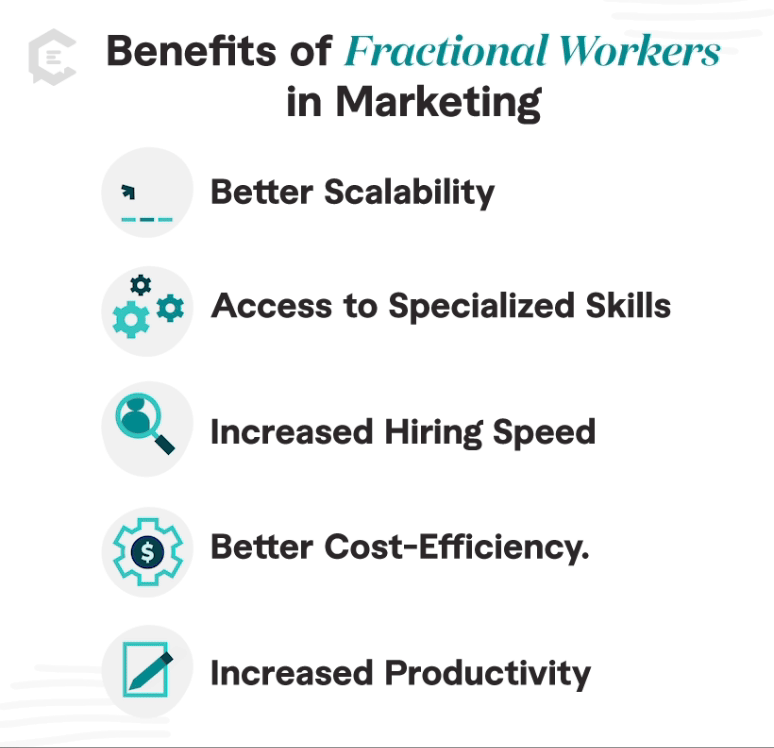Hiring fractional workers lets you tap into top talent without committing to a full-time position. Pretty convenient, right? But, managing them comes with its own set of challenges. Even though they’re only with your marketing team part-time, they need to mesh well with your full-timers. Plus, keeping them motivated and on deadline can sometimes be a juggle.
Let’s dive into how you can manage your fractional team effectively, boosting productivity and creating a team that works well together.

Understanding Fractional Employment
Fractional employment involves hiring professionals with specialized skills for a “fraction” of their time. These fractional workers will work for your team for a predetermined number of hours. They typically have arrangements with multiple organizations on a part-time or project basis.
Marketing teams may consist of fractional talent with expertise in SEO, social media management, content production, and more. Some teams even have fractional CMOs to oversee their marketing operations.
Benefits of Fractional Workers in Marketing
Independent workers can help your fractional marketing team scale and reduce costs. Let’s break down the key benefits based on a study by the Society for Human Resource Management (SHRM):
- Better Scalability. You can scale your team up or down as needed and align your resources based on project demand. The flexibility to reduce capacity, if demand drops, is the biggest benefit that 35 percent of respondents realized from hiring independent workers.
- Access to Specialized Skills. A fractional model expands your talent pool, enabling you to tap into niche skills that are difficult to find in your market. The ability to access specialized skills was the second most realized benefit of hiring independent workers.
- Increased Hiring Speed. Working with fractional workers allows you to bypass the lengthy and complicated hiring process that you have in place for bringing on full-time employees. You can significantly boost efficiency when you quickly bring in the talent needed to get started on your projects.
- Better Cost-Efficiency. When you hire fractional workers, you only pay for the time you need them instead of spending on full-time salaries and benefits. That means you can still access top talent minus the overhead of bringing in someone full-time. According to Christine Pilkington, CEO and founder of Crisp, this gives you “financial breathing room” to enhance your business’ stability during challenging times.
- Increased Productivity. Fractional workers typically have years of experience with established workflows, allowing them to work faster. This increases your productivity and helps you complete projects much faster.
Integrating Fractional Employees
Managing a hybrid team of fractional and in-house employees requires seamless collaboration for success. To accomplish this, you need to ensure that your fractional employees are properly integrated into the existing team. Make sure your onboarding process considers the unique requirements of integrating fractional workers.
Onboarding Strategies for Fractional Workers
- Pre-boarding: Before the first day, provide essential resources like company information, brand guidelines, and access to relevant tools.
- Roles and Responsibilities: Provide a detailed job description outlining specific tasks, deliverables, and expectations.
- Dedicated Onboarding Session: Organize an onboarding session to introduce the fractional employee to the team, their role, and project expectations.
- Mentorship Program: Pair the fractional worker with a team member who can provide ongoing guidance and answer questions.
Tools and Technologies for Integration
- Project Management Tools: Use project management platforms like Asana or Trello to ensure everyone is aligned on tasks, deadlines, and project progress.
- Communication Tools: Invest in tools like Slack or Microsoft Teams to facilitate real-time collaboration and information sharing.
- Knowledge Management Tools: Use tools like Google Drive or Dropbox to create a centralized repository for documents, project files, and brand assets.
Motivating Fractional Workers
To get the most value out of your fractional workers, you need to make sure they’re motivated to give their best when working with your team. That means recognizing their impact on your organizational culture. It’s important to foster a sense of belonging while ensuring their contributions are rewarded or recognized.
Setting Clear Expectations and Goals
When you’re clear about what you expect from your fractional workers, they’re more likely to feel motivated. Make sure to define the following:
- Specific, Measurable, Achievable, Relevant, and Time-Bound (SMART) goals: This provides a roadmap for success and a sense of accomplishment.
- Performance Metrics: Establish clear metrics to track progress and measure the impact of their work.
- Regular Feedback: Provide constructive feedback to guide improvement and showcase their value. This is one of the key practices differentiating high-performing organizations from low-performing ones in the SHRM study.
Reward and Recognition
Fractional workers need to feel acknowledged for their contributions even if they don’t get to experience traditional benefits. In fact, 59 percent of high-performing organizations in the SHRM study clearly recognize independent workers for their contributions. Here are a few ideas:
- Performance-Based Incentives: Consider offering bonuses or rewards to exceed expectations.
- Public Recognition: Highlight their achievements in team meetings or company communications.
- Professional Development Opportunities: Offer opportunities to attend workshops or conferences to enhance their skills.
Ensuring Effective Communication
Effective communication is the foundation of managing any team. This is especially true for hybrid teams that use fractional members. Here’s how to bridge potential communication gaps:
Communication Tools and Techniques
- Establish clear communication channels and set expectations on response times.
- Schedule weekly or bi-weekly video calls to discuss progress, address issues, and brainstorm ideas.
- Encourage fractional employees to be readily available through designated communication channels. Tools like Slack or Microsoft Teams can help with real-time collaboration and knowledge sharing. You can also use video conferencing tools like Zoom or Google Meet for team meetings and one-on-one conversations.
- Encourage written communication through email threads or project management tools for clear documentation.
- Keep them informed about broader company goals and updates to maintain a sense of connection.
Regular Check-ins and Feedback
Your fractional workers may experience roadblocks that are hindering progress. Give them the opportunity to share these issues with you through regular check-ins. Provide feedback and assistance where needed.
Collect their opinions about team dynamics, workflows, and project processes, and use these insights to inform your management strategies. This will help you create a safe space for fractional employees to voice their concerns and ideas.
Managing Productivity and Performance
One of the biggest challenges of managing a hybrid team is maintaining productivity. You must ensure that your fractional employees are consistently productive and on track to meet project deadlines. This makes it crucial to closely track your team’s performance and address any productivity challenges.
Tracking and Measuring Productivity
Make use of technology and proven strategies to assess performance:
- Time Tracking Tools: Track the time spent on tasks associated with specific projects to optimize workflow.
- Performance Reviews: Conduct regular performance reviews to evaluate progress toward goals and adjust strategies if needed.
- Outcome-Based Evaluation: Focus on measuring the impact of their work on key performance indicators (KPIs) for marketing campaigns.
Addressing Productivity Challenges
Proactively address potential any challenges that are hindering the productivity of your fractional team:
- Set Realistic Workloads: Avoid over-burdening fractional employees to ensure they can dedicate focused time to their projects. Offer them flexibility when possible, but be clear about deadlines and expectations.
- Minimize Context Switching: Minimize disruptions by scheduling dedicated work blocks for focused tasks.
- Provide Clear Communication Channels: Ensure easy access to guidance and support from in-house colleagues.
Scale Efficiently with a Fractional Team
Having access to fractional talent allows your organization to grow its capabilities without the cost of hiring full-time workers. You also have the flexibility to scale up or down and adjust your resource allocation based on project demand.
ClearVoice offers a host of content solutions to support your marketing team. Tap into an expansive network of freelancers with specialized skills and educational expertise to align with your projects. Or enjoy managed content production and let us handle every aspect of your content for your entire funnel.
Ready to start the conversation? Talk to a content strategist today to learn how ClearVoice can help benefit your fractional team.








